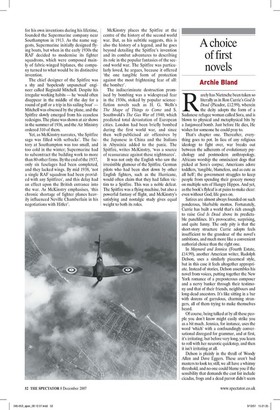A love story
Daniel Swift SPITFIRE: PORTRAIT OF A LEGEND by Leo McKinstry John Murray, £20, pp. 435, ISBN9780719568749 £16 (plus £2.45 p&p) 0870 429 6655 The pilots called it 'the Spit', 'my personal swallow', 'a real lady', or, simply, 'the fabulous Spitfire'. It was not a perfect machine. Due to its long nose, forward visibility during take-off was poor; it was freezing cold in the cockpit, and so small that the pilot did not have room to wear a bulky flight suit. He had to make do with chamois leather gloves and wool socks. Yet all who flew it marvelled at its grace and power, and it was equally adored by those on the ground. As Leo McKinstry notes, in his thorough and engaging new account of the invention and development of this most glamorous machine, when in 1940 Spitfire funds were established throughout the country, 'It is the only time in British history that vast numbers of citizens have voluntarily, even enthusiastically, donated money directly to the government.' The history of the Spitfire is above all a love story.
The elegant little fighters, with their distinctive elliptical wings and purring Merlin engines, are most famous for combat during the Battle of Britain, when they held back the Luftwaffe's attempts to destroy British air defences, and therefore arguably prevented the long-planned German land invasion of Britain. As McKinstry recounts, they served also in photo-reconaissance, and were central to the defence of Malta in the spring of 1942. They saw their first intensive combat in May 1940, over Dunkirk. Later in the war, they provided initial cover for the troop landings at D -Day, and subsequently 'some Spitfires even delivered beer to RAF personnel, the bomb racks under the wings carrying barrels'.
The colourful story begins with the Honourable Noel Pemberton Billing, a monocle-wearing `right-wing politician, prolific inventor, theatrical impresario, magazine publisher and aeronautical pioneer'. Billing, who was obsessed by the threat of lesbianism infiltrating English society during the first world war, and who took out no fewer than 2,000 patents for his own inventions during his lifetime, founded the Supermarine company near Southampton in 1913. As the name suggests, Supermarine initially designed flying boats, but when in the early 1930s the RAF decided to modernise its fighter squadrons, which were composed mainly of fabric-winged biplanes, the company turned to what would be its distinctive invention.
The chief designer of the Spitfire was a shy and 'hopelessly unpunctual' engineer called Reginald Mitchell. Despite his irregular working habits — he 'would often disappear in the middle of the day for a round of golf or a trip in his sailing boat' — Mitchell was obsessed by the plane, and the Spitfire slowly emerged from his ceaseless redesigns. The plane was shown at air shows in the summer of 1936, and the Air Ministry ordered 310 of them.
Yet, as McKinstry narrates, 'the Spitfire saga was filled with setbacks'. The factory at Southampton was too small, and too cold in the winter; Supermarine had to subcontract the building work to more than 80 other firms. By the end of the 1937, only six fuselages had been completed, and they lacked wings. By mid 1938, 'not a single RAF squadron had been provided with any Spitfires', and this delay had an effect upon the British entrance into the war. As McKinstry emphasises, 'this chronic shortage of fighter planes heavily influenced Neville Chamberlain in his negotiations with Hitler'.
McKinstry places the Spitfire at the centre of the history of the second world war. But, as his subtitle suggests, this is also the history of a legend, and he goes beyond detailing the Spitfire's invention and its combat adventures to describing its role in the popular fantasies of the second world war. The Spitfire was particularly loved, he argues, because it offered 'the one tangible form of protection against the most frightening fear of all: the bomber'.
The indiscriminate destruction prom ised by bombing was a widespread fear in the 1930s, stoked by popular sciencefiction novels such as H. G. Wells's The Shape of Things to Come and S. Southwold's The Gas War of 1940, which predicted total devastation of European cities. London had been briefly bombed during the first world war, and since then well-publicised air offensives by the Japanese in China and the Italians in Abyssinia added to the panic. The Spitfire, writes McKinstry, 'was a source of reassurance against these nightmares'.
It was not only the English who saw the irresistible glamour of the Spitfire. German pilots who had been shot down by other English fighters, such as the Hurricane, would often claim that they had fallen victim to a Spitfire. This was a noble defeat. The Spitfire was a flying machine, but also a powerful fantasy of flight, and McKinstry's satisfying and nostalgic study gives equal weight to both its roles.


























































 Previous page
Previous page